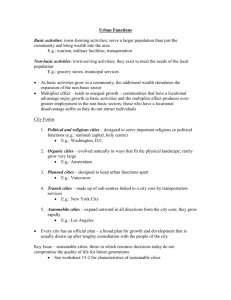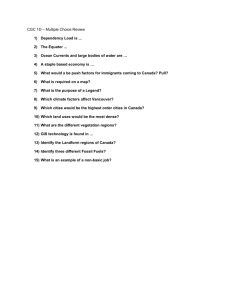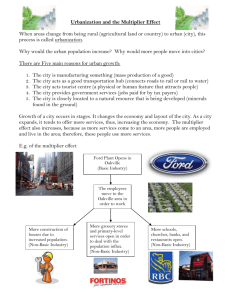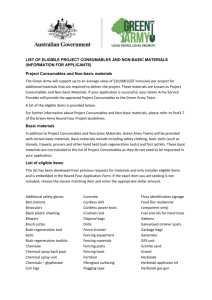PPT - Foundation Coalition
advertisement
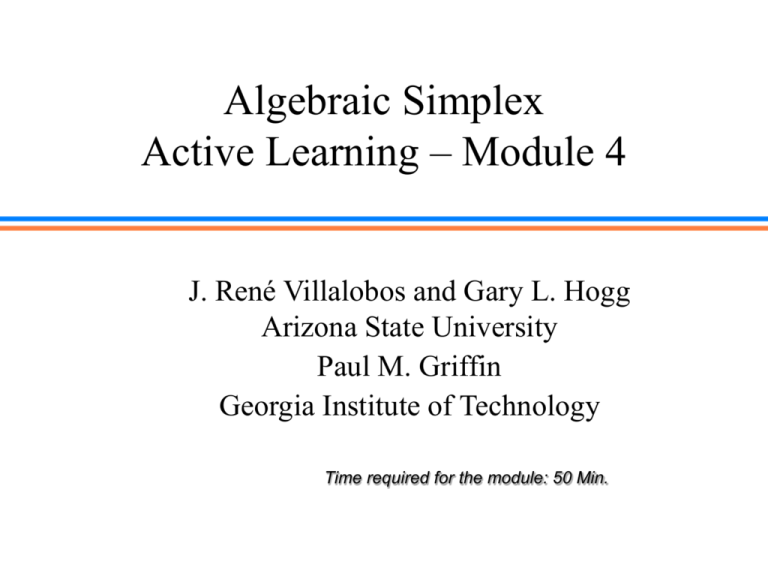
Algebraic Simplex Active Learning – Module 4 J. René Villalobos and Gary L. Hogg Arizona State University Paul M. Griffin Georgia Institute of Technology Time required for the module: 50 Min. Reading Most of the introductory/intermediate textbooks in Operations Research have a chapter that covers the fundamentals of the simplex algorithm. The students should read this chapter before coming to class. Two suggestions: Chapter 3 of Operations Research, by Hamdy A. Taha, Prentice Hall , 7th Edition Chapter 4 of Introduction to Operations Research by Hillier and Liberman, 7th Edition The student should also read the self-contained module on the standard form of an LP problem. This module can be downloaded from: http://enpc2675.eas.asu.edu/lobos/iie476/stdform.doc While not required, it is recommended that the active learning module on the Simplex Tableau is read before reading this module Lecture objectives At the end of the lecture each student should be able to: Explain the logic behind the algorithmic steps of the Simplex Algorithm Find the optimal solution of a Linear Programming problem by using the algebraic approach of the Simplex Algorithm Time Management Introduction 3 minutes RAT 5 minutes Lecturing on the mechanics of the Simplex Algorithm 20 minutes Team exercise 7 minutes Lecturing on Simplex algorithm 10 minutes Wrap up 5 minutes Total lecture time 50 minutes Individual Exercise Readiness Assessment test(3 minutes) Setup the following problem as a standard LP Problem: Minimize z = 3x + 5y – 3z Subject to: -3x - 2y + 5z -20 x + y 10 z4 At the end of the exercise turn in your solution Solution Minimize z = 3x + 5y – 3z Subject to: +3x + 2y - 5z 20 x + y 10 y4 Maximize -z = -3x - 5y + 3z Subject to: +3x + 2y - 5z +S1= 20 x + y + S2 =10 Y- S3 = 4 Solution of a Linear Programming Problem Once a problem can be expressed as a linear programming problem the next step is to find its optimal solution For trivial 2 and 3 decision variable problems their optimal solution can be found graphically For more complex problems the simplex algorithm is traditionally used. In this lecture we use illustrate the algebraic operations of the Simplex Algorithm In order to use the simplex algorithm it is necessary to: Express the problem in a standard form Represent the objective function as an equation z c j j 0; j where z is the value of the objective function and the xj’s the decision variables Standard Form We define the standard form of a linear programming problem as: One whose objective function is maximization One whose constraints are expressed as equations and whose right hand side is non-negative (after the introduction of slack and surplus variables) One in which all the decision variables are nonnegative Example: Setting up the ReddyMikks Problem For Instance the Reddy-Mikks Is expressed as: Problem: Maximize z = 3XE + 2XI z - 3XE - 2XI - 0S1 - 0S2 - 0S3- 0S4 Subject to: Subject to: XE + 2XI 6 (1) XE + 2XI + S1 = 6 (1) 2XE + XI 8 2XE + XI = 8 (2) (2) -XE + XI 1 (3) XI 2 (4) XE , XI, 0 -XE + XI XI + S2 + S3 = 1 (3) + S4= 2 (4) XE , XI,, S1,, S2,, S3,, S4 0 Maximization is implied by the (+1)z since it is the objective function of the standard form. Conceptual Outline of the Steps of the Simplex Algorithm Step 0: Using the standard form determine a starting basic feasible solution by setting n-m non-basic variables to zero. Step 1: Select an entering variable from among the current non-basic variables, which gives the largest per-unit improvement in the value of the objective function. If none exists stop; the current basic solution is optimal. Otherwise go to Step 2. Step 2: Select a leaving variable from among the current basic variables that must now be set to zero (become non-basic) when the entering variable becomes basic. Step 3: Determine the new basic solution by making the entering variable, basic; and the leaving variable, non-basic, and return to Step 1. Example 1: Reddy-Mikks Problem Step 0.- Since we have four equations representing the constraints we can have at most four linearly independent variables to get the solution of the system of equations. We set XE , XI, to zero (non-basic variables) and solve for S1,, S2,, S3,, S4 (basic variables). Notice that we easily get a feasible solution. In particular a basic feasible solution. z -3XE -2XI - 0S1 - 0S2 - 0S3- 0S4 XE +2XI + S1 = 6 (1) 2XE + XI + S2 = 8 (2) -XE + XI + S3 = 1 (3) XI + S4= 2 (4) XE , XI,, S1,, S2,, S3,, S4 0 z -3XE -2XI - 0S1 - 0S2 - 0S3- 0S4 = 0 (0) XE +2XI + S1 = 6 (1) 2XE + XI + S2 = 8 (2) -XE + XI + S3 = 1 (3) XI + S4 = 2 (4) XE , XI,, S1,, S2,, S3,, S4 0 Example 1: Reddy-Mikks Problem xI 8 6 4 Current Solution: XE =0 XI =0 S1 =6 S2 =8 S3 =1 S4 =2 2 2 4 6 xE Example 1: Reddy-Mikks Problem (Cont.) Step 1.- Select an entering variable from among the current non-basic variables which can improve the value of the objective function. Current non-basic variables: XE , XI, Objective function: z -3XE - 2XI + 0S1 + 0S2 + 0S3+ 0S4 Thus increasing the value of either of the non-basic variables will improve the current solution (z=0). Since the per-unit contribution of XE (3) is higher than XI (2) we select XE as the entering (new basic) variable. (Note that these per-unit contributions are the partial derivatives of the Objective Function) Example 1: Reddy-Mikks Problem xI 8 6 Increasing XI by unit results in an increase of Z of 2 units Increasing XEby unit results in an increase of Z of 3 units 4 2 XE =0 XI =0 S1 =6 S2 =8 S3 =1 S4 =2 2 4 6 xE We select to increase the value of XE How much can we increase XE? The amount of the increase is limited by the constraints (One of the slack variables becomes zero or non-basic) Example 1: Reddy-Mikks Problem (Cont.) Step 2: Select a leaving variable from among the current basic variables that must be set to zero (become non-basic) when the entering variable becomes basic. Since we want to increase the value of XE as much as possible we increase it until one of the slack variables becomes zero (it then becomes non-basic). In this case S2 (when the value of XE is increased to 4) is the one that that becomes non-basic. (To see this use the original equations and ask how big XE can be before the slack variable is driven to zero in each equation.) Note that by doing a single pair wise exchange of basic(leaving) and non-basic (entering) variables result in moving to an adjacent corner) Example 1: Reddy-Mikks Problem (Cont.) Step 3: Determine the new basic solution by making the entering variable, basic; and the leaving variable, non-basic. z -3XE -2XI - 0S1 - 0S2 - 0S3- 0S4 = 0 (0) XE +2XI + S1 = 6 (1) 2XE + XI + S2 = 8 (2) -XE + XI + S3 = 1 (3) XI + S4 = 2 (4) XE , XI,, S1,, S2,, S3,, S4 0 We need to solve this system of equations Use elementary row operations to the get the proper form. Apply this to all the variables We return to step 1. z-0XE - 0.5XI - 0S1+1.5S2-0S3-0S4 = 12(0) 1.5XI + S1 –0.5S2 = 2 (1) XE +0.5XI +0.5S2 = 4 (2) 1.5 XI +0.5S2 + S3 = 5 (3) XI + S4= 2 (4) XE , XI,, S1,, S2,, S3,, S4 0 Example 1: Reddy-Mikks Problem xI We have moved from the original corner-point feasible 8 solution to another with a higher objective function 6 Z = 12 XE =4 XI =0 S1 =2 S2 =0 S3 =5 S4 =2 4 Z=0 XE =0 XI =0 S1 =6 S2 =8 S3 =1 S4 =2 2 2 4 6 xE Example 1: Reddy-Mikks Problem Step 1.- Select an entering variable from among the current non basic variables which gives the greatest per-unit improvement in the value of the objective function. Current non-basic variables: XI ,, S2 We select XI since it is the only one that will improve the current value of objective function z-0XE - 0.5XI - 0S1+1.5S2-0S3-0S4 = 12(0) 1.5XI + S1 –0.5S2 = 2 (1) XE +0.5XI +0.5S2 = 4 (2) 1.5 XI +0.5S2 + S3 = 5 (3) XI + S4= 2 (4) XE , XI,, S1,, S2,, S3,, S4 0 Team Exercise (5 min) In Step 1 of the previous iteration we decided to use the variable XE as the entering variable because of its marginal contribution to the improvement of the objective function (3 units) over the marginal contribution of the variable XI (2 units). In the current solution the marginal contribution of XI to the improvement of the objective function is only 0.5 units, why? Give a plausible explanation to the difference in the marginal contribution of XI In words Graphically The instructor will randomly select the members of two teams to give their solutions Solution Since XE is bound by a constraint that is a function of XE and xI XI,if we increase XI we need to reduce XE by an amount dictated 8 by the constraint. Thus, increasing XI by one unit will not result in an increase of z by the original marginal contribution of XI. 6 With the constraint increasing a unit of XI results in an increase of z of 0.5 4 0.5 Without constraints increasing a unit of XI resulted in an increase of z of 2 2 2 4 2 6 xE Example 1: Reddy-Mikks Problem (Cont.) Step 1.- Select an entering variable from among the current non basic variables which gives the greatest per-unit improvement in the value of the objective function. Current non-basic variables: XI ,, S2 We select XI since it is the only one that will improve the current value of objective function Step 2: Select a leaving variable from among the current basic variables that must be set to zero (become non-basic) when the entering variable becomes basic. Since we want to increase the value of XI as much as possible we do that until one of the current basic variable becomes zero (nonbasic). In this case S1 (when the value of XI is increased to 4/3) is the one that that becomes non-basic. Example 1: Reddy-Mikks Problem (Cont.) Step 3: Determine the new basic solution by making the entering variable basic; and the leaving variable, non-basic. z-0XE - 0.5XI - 0S1+1.5S2-0S3-0S4 = 12(0) 1.5XI + S1 –0.5S2 = 2 (1) XE +0.5XI +0.5S2 = 4 (2) 1.5 XI +0.5S2 + S3 = 5 (3) XI + S4= 2 (4) XE , XI,, S1,, S2,, S3,, S4 0 z-0XE+0XI+0.33S1+1.33S2-0S3-0S4= 12.66 (0) XI +0.66S1 –0.33S2 = 1.33 (1) XE -0.33S1 +0.66S2 = 3.33 (2) - 1.0S1 +1.0S2 + S3 =3 (3) -0.66S1 +0.33S2 + S4 = 0.66 (4) XE , XI,, S1,, S2,, S3,, S4 0 When we now return to step 1 no further improvement is indicated so we stop; this is the optimum (maximum). Summary The simplex starts from a basic feasible solution By exchanging one basic for one non-basic variables it moves from one corner point solution to an adjacent, more promising, corner point solution It continues with this process until it reaches the optimal solution of the LP problem Assignment Find the optimal solution of the Report Strategy Problem by using the algebraic simplex method. As part of the assignment show the corner points visited in the 2D graph of the problem.
